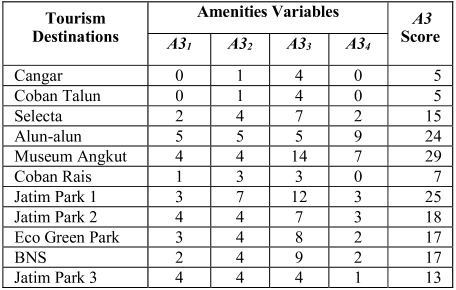




Did you find this useful? Give us your feedback













36 citations
...They presented the 6AsTD framework and TOPSIS method as a combination concept to rank medical tourism destinations....
[...]
...They used GIS model for locating destinations and used the TOPSIS method for ranking them....
[...]
...The acronym TOPSIS stands for Technique for Order Performance by Similarity to Ideal Solution....
[...]
...TOPSIS Arif et al. (2019) investigated medical tourism destination priority in Batu City....
[...]
...Morovati Sharifabadi, A.; AsadianArdakani, F. Offering a model with the hybrid method of Fuzzy TOPSIS and structuralinterpretive modeling in Yazd....
[...]
18 citations
...These components include attractions, accessibility, amenities, available packages, activities, and ancillary services [34]....
[...]
10 citations
7 citations
3 citations
2,779 citations
...In this framework, attractions (A1) have four variables include natural landscape (A11), artificial tourism (A12), cultural tourism (A13) and special events (A14) [7][8][2]....
[...]
...Tourism destination is also an area chosen by visitors to carry out tourism activities, covering all available facilities, including entertainment facilities, accommodation, lodging, restaurants, and so on [7][2]....
[...]
...Among them are the Premier-Ranked Tourist Destination Framework (PRTDF) and 6As of Tourism Destinations (6AsTD) Framework [6][7]....
[...]
...This framework, first introduced by Dimitrios Buhalis, has six main components, shown in figure 1 [7][8][2]....
[...]
...These variables include lodging and hotels (A31), restaurants (A32), public facilities (A33) and shopping centers (A34) [7][8][14][16]....
[...]
488 citations
...These facilities can be available both inside and surround it [2]....
[...]
...We can see the success of tourism destinations through the availability of existing support facilities and service [2]....
[...]
...In this framework, attractions (A1) have four variables include natural landscape (A11), artificial tourism (A12), cultural tourism (A13) and special events (A14) [7][8][2]....
[...]
...Tourism destination is also an area chosen by visitors to carry out tourism activities, covering all available facilities, including entertainment facilities, accommodation, lodging, restaurants, and so on [7][2]....
[...]
...This framework, first introduced by Dimitrios Buhalis, has six main components, shown in figure 1 [7][8][2]....
[...]
200 citations
...If tourism is well developed, then the economy will also run well [1]....
[...]
156 citations
...The following is the TOPSIS procedure used in this study [19][20]:...
[...]
126 citations
...TOPSIS is one of the techniques in multiple-criteria decision-making that can solve the problems with several attributes clearly and systematically [9][10]....
[...]